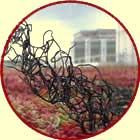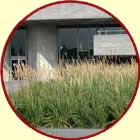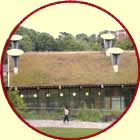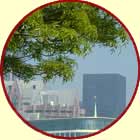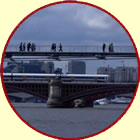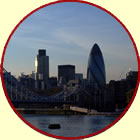 Organisations -
Organisations -
Practical ideas
Every organisation, large or small, can do something for biodiversity.
Why not ...
provide a home for London's airborne residents
 Bird and bat boxes are simple to erect on existing buildings, or can be incorporated into the design of new ones. Some of London's most iconic buildings are home to our most impressive winged-neighbours. Battersea Power Station has had a peregrine platform since the year 2000.
Bird and bat boxes are simple to erect on existing buildings, or can be incorporated into the design of new ones. Some of London's most iconic buildings are home to our most impressive winged-neighbours. Battersea Power Station has had a peregrine platform since the year 2000.
motivate your staff
![]() Spend a day or two volunteering. Reed Elsevier staff used their volunteer days to help plant a reedbed in St James's Park. The volunteers' enthusiasm has encouraged their colleagues to get involved in broader environmental campaigns.
Spend a day or two volunteering. Reed Elsevier staff used their volunteer days to help plant a reedbed in St James's Park. The volunteers' enthusiasm has encouraged their colleagues to get involved in broader environmental campaigns.
take an organisational approach
 Create your own biodiversity action plan, like London Underground. Action plans are a useful planning tool, they embed biodiversity into your organisation, and demonstrate your commitment to CSR to staff and investors alike. Get in touch with the Partnership to find out more.
Create your own biodiversity action plan, like London Underground. Action plans are a useful planning tool, they embed biodiversity into your organisation, and demonstrate your commitment to CSR to staff and investors alike. Get in touch with the Partnership to find out more.
green your buildings and developments
 Make space for wildlife in our crowded city. Provide a rooftop home for invertebrates; or incorporate boxes into your brickwork for birds or bats, or greenery for your walls. For more ideas on designing for biodiversity see the London Design for Biodiversity website.
Make space for wildlife in our crowded city. Provide a rooftop home for invertebrates; or incorporate boxes into your brickwork for birds or bats, or greenery for your walls. For more ideas on designing for biodiversity see the London Design for Biodiversity website.
pass it on
 Audit your supply chain - ask your contractors what they are doing for biodiversity. Use your purchasing power to influence others - ensure that biodiversity is protected at home and abroad.
Audit your supply chain - ask your contractors what they are doing for biodiversity. Use your purchasing power to influence others - ensure that biodiversity is protected at home and abroad.
soften your hard landscaping
One Thames-side factory decided on a natural solution to the problem of pollution run-off into the river. They built their new car park around a central reedbed and lagoon that absorbed water run-off, provided natural water treatment and a haven for people and wildlife. For more ideas, see the London Design for Biodiversity website.
get a march on your competitors
 Access advice and make an active contribution to London's biodiversity. Join the London Biodiversity Partnership as a partner.
Access advice and make an active contribution to London's biodiversity. Join the London Biodiversity Partnership as a partner.
case studies
Boroughs and other organisations across London are finding innovative ways to make space for biodiversity.
London Borough of Southwark -
Countisbury House and Lapse Wood Housing Estate grounds management
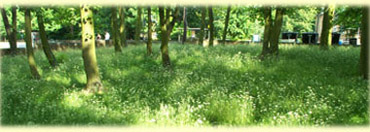
The lawns of the 1960s Countisbury House estate in Upper Sydenham harbour a large population of a rare wildflower - the corky-fruited water-dropwort. On advice from London Wildlife Trust, the Council adopted a mowing regime to benefit this and other wildflowers. Residents are delighted with their enhanced floral outlook and this example has fuelled interest in less-manicured and more diverse grounds elsewhere in the borough.






